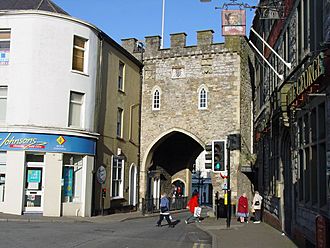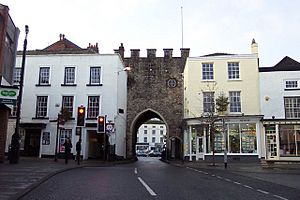Chepstow Town Gate facts for kids
Quick facts for kids Town Gate, Chepstow |
|
|---|---|

The Town Gate from the west, with the George Hotel on the right
|
|
| General information | |
| Town or city | Chepstow |
| Country | Wales |
| Coordinates | 51°38′27″N 2°40′36″W / 51.640966°N 2.676558°W |
| Completed | c.1278 Rebuilt 1524 |
| Renovated | 1985-86 |
| Designations | Grade I listed |
The Town Gate in Chepstow, Wales, is also called the Town Arch. For a long time, it was the only way to enter the town by land. People also paid tolls here to bring goods to the market. The gate was first built in the late 1200s, along with the town wall. The archway you see today is mostly from the 1500s. It has been repaired and rebuilt many times. You can find it at the west end of Chepstow's High Street. It is a very important historic building, listed as Grade I.
Contents
History of the Town Gate
After the Normans took over parts of south Wales, Chepstow became a busy port. It was an important trading place. Around 1270, a powerful lord named Roger Bigod, 5th Earl of Norfolk took control of Chepstow.
Building the Town Gate
Roger Bigod started many building projects in Chepstow. He built new parts of Chepstow Castle. He also rebuilt Tintern Abbey nearby. Bigod was also responsible for building the Port Wall and the Town Gate. These were built between 1274 and 1278.
In 1294, Bigod allowed a regular market to be held in Chepstow. The Port Wall and Town Gate made sure that only people who paid tolls could enter the market. Tolls were like a fee to use the market. The gate also helped keep out unwanted people from the countryside.
What the Gate Looked Like
The Town Gate is a square building with battlements on top. Battlements are the notched walls often seen on castles. It used to have a portcullis, which was a heavy gate that could be lowered. This portcullis is no longer there.
The gate is surrounded by other buildings. On the east side is the Gate House. To the west is the George Hotel. On the western side of the gate, you can see two old, worn statues of angels. These probably date from 1524. At that time, Charles Somerset, 1st Earl of Worcester rebuilt parts of the gate.
The Gate's Many Uses
In 1524, the Earl of Worcester gave Chepstow a special charter. This allowed the town's officials to use the room above the archway as a prison. The gate was called the "New Gate" in 1687. This suggests there might have been an older gate in the area before.
Tolls were collected at the gate for animals and goods brought into the market. People also paid tolls if they bought livestock at the town's fairs.
Battles and Changes
In 1648, there was a small fight at the gate. Oliver Cromwell's soldiers fought the town's Royalist defenders. Cromwell's troops entered the town and later took over the castle. In 1756, people from the nearby Forest of Dean raided Chepstow. They had to be driven away by guns placed on the Town Gate and the Wye Bridge. Tolls continued to be collected until 1874.
The Town Gate belonged to the Dukes of Beaufort for many years. In 1899, the 9th Duke of Beaufort wanted to sell the building. However, the Chairman of the Town Council convinced him to give it to the town instead. A special plaque on the building thanks the Duke for his gift.
Modern Times
In 1928, a tiled path for people was made through the Gate House. The room above the archway was used as a storeroom, workshop, and office. In 1949, it became the first home of Chepstow Museum.
The entire building was fully repaired between 1985 and 1986. During this work, a doorway from the 1200s was found inside. A new plaque was put up in March 1986 to celebrate the restoration. It was designed by local artist Keith Underwood.
The Town Gate was given Grade I Listed Building status on June 12, 1950. This means it is a very important historic building. Today, traffic lights control cars going through the single archway.
Buildings Next to the Gate
The Gate House
The Gate House is right next to the Town Gate. It was rebuilt in 1609 for Margaret Cleyton. She was a rich widow who gave money to good causes. The date is carved above its doorway. Her fancy tomb is in St Mary's Church, Chepstow.
The Gate House has been used for many things. It was a brewery, a farmhouse, a doctor's office, and a bank. In 1919, an engineer named J.H. Silley gave it to the town. He helped bring a big shipyard to Chepstow during the First World War. After that, it became the offices for the local council. Today, the Town Council and Citizens' Advice Bureau use it.
The George Hotel
On the other side of the Town Gate is the George Hotel. Margaret Cleyton also built the first hotel here around 1620. It became one of the town's main coaching inns. Coaching inns were places where horse-drawn coaches would stop for travelers to rest.
The original building was completely destroyed by fire in May 1896. But it was rebuilt and opened again in 1899. The area outside the gate was once a place where people traded without paying tolls. There was even a stone cross called "Robin Hood's Cross" here until 1759. Trading continued in the streets until a new livestock market was built in 1893.


